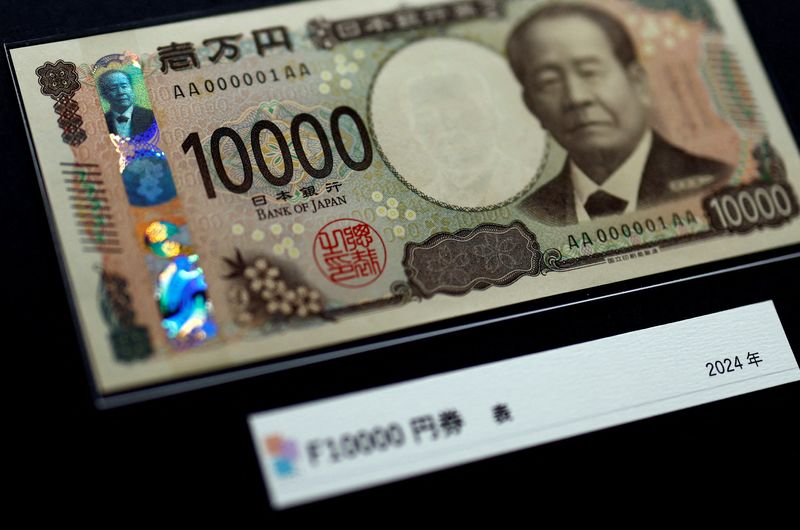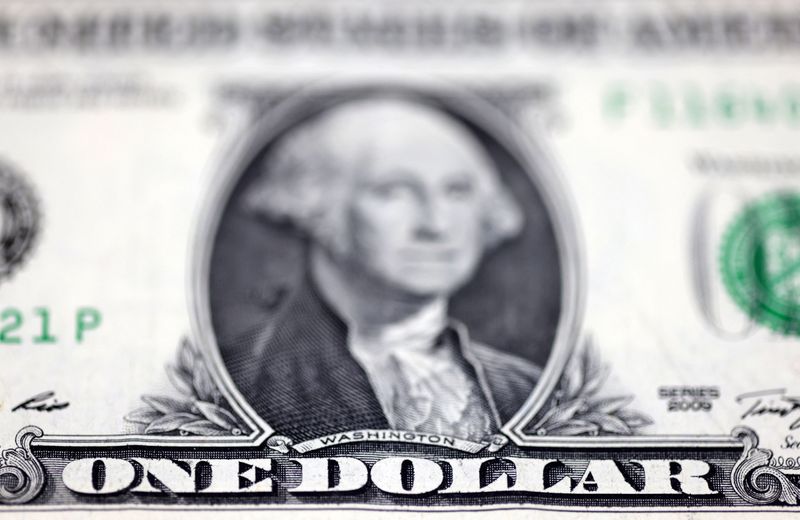
By Saqib Iqbal Ahmed
NEW YORK (Reuters) -The U.S. dollar sank to a near 7-month low against a basket of peers on Monday, and sold off sharply against the euro and the Japanese yen, as a slew of economic data last week raised the prospect of a U.S. economic downturn and bigger rate cuts from the Federal Reserve.
The dollar index, which tracks the U.S. currency against a basket of six others, was down 0.7% to 102.39, after sinking as low as 102.15, its weakest since January 12.
The euro was up 0.5% to $1.0968, after rising as high as $1.1009, its strongest since January 2. Against the yen, the dollar fell 2.3% to 143.13, close to the weakest level for the year.
Weaker-than-expected U.S. jobs data, along with disappointing earnings reports from large technology firms and heightened concerns over the Chinese economy, have sparked a global sell-off in stocks, oil and high-yielding currencies in the past week as investors sought the safety of cash.
The selling continued on Monday, with U.S. Treasury yields falling further, stock indexes in the red, bitcoin dumped and the dollar losing ground.
“As traders continue to pile into bets that the Fed is going to ease a very large amount more this year than thought even as recently as Wednesday, USD is taking a bit of a beating with a couple notable exceptions,” Helen Given, FX trader at Monex USA in Washington, said.
“Friday’s NFP report was a bit of a shock to the global system and markets are very worried that the US may no longer be a viable driver of global growth,” she said.
Treasury yields have been falling sharply since last week, when the Federal Reserve kept the policy rate in its current 5.25% to 5.50% range while Chair Jerome Powell opened the possibility of a rate cut in September.
But by Friday, after data showed the unemployment rate had jumped, expectations for rate cuts rose.
The Japanese yen’s surge comes as traders aggressively unwound carry trades. So-called carry trades, where investors borrow in money from economies with low interest rates such as Japan or Switzerland to fund investments in higher-yielding assets elsewhere, have been popular in recent years.
On Monday, Fed fund futures reflected traders pricing a near 100% chance of a 50 basis point cut at the central bank’s September meeting, according to CME FedWatch. Futures imply 127 basis points of cuts this year, LSEG data showed.
“The Japanese equity selloff during Asian trading spooked markets in a big way, coupled with the Yen’s resurgence, and we may be seeing the so-called ‘panic spiral’ that many have been concerned about,” Monex’s Given said.
Meanwhile, the Swiss franc, another popular carry trade funding currency, was about 1% higher at 0.8499 to the dollar. The franc, a traditional safe haven, was also trading at a seven-month high.
“(It) all seems a significant over-reaction to one weak jobs report, particularly when we know that the FOMC shan’t over react from a policy perspective,” Michael Brown, market analyst at Pepperstone in London, said.
The dollar found some relief against the British pound as the marked deterioration in global investor risk sentiment sapped demand for riskier currencies.

The depreciation of Mexico’s peso extended into its third day on Monday, and the U.S. dollar rose 1.9% to 19.53 pesos, on investor risk aversion.
In cryptocurrencies, bitcoin and ether plunged on Monday to multi-month lows as investors a rushed out of risky assets. Bitcoin was down 14% to $54,078, heading for its largest one-day fall since November 2022. Ether was down slid as much as 21% to its lowest since January.
This post is originally published on INVESTING.


